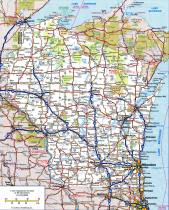I recently read A conversation with Ken Jennings and Jesse James Garret. @UXMagazine about Ken Jennings’ book Mapheads which was published in 2014. They discuss the relationship of maps and design. It reminded me of my early love for maps and the fascination I’ve had with them over time. As quoted from Ken Jennings “…elegance of the map as a solution to a visual problem ‘How do I convey information about the world?’ This is at the core of the UX designers goals.

Every summer, my family would hit the open road for a vacation that normally included a lot of driving in our Ford Fairmont wagon, stops at seemingly random roadside historical markers and trips to baseball stadiums that were supposedly “on our way” to our final destination.
I lay in the “way back” section of the car, pouring over the intended route while imagining, alternate ways to get where we were going. Reviewing the various map symbols, topography and exchanges almost became another outlet for daydreaming and envision the possible excitement that lay ahead in the journey. It also caused me to think about how I would represent the  landmarks as we passed them by and I saw exactly what they looked like. I recognized this desire to store and think about information in a spatial way. Ken Jennings shares his thoughts about it by saying. “That spatial way of storing information is apparently deeply hardwired into how our brain wants to learn things.”
landmarks as we passed them by and I saw exactly what they looked like. I recognized this desire to store and think about information in a spatial way. Ken Jennings shares his thoughts about it by saying. “That spatial way of storing information is apparently deeply hardwired into how our brain wants to learn things.”
This reminded me of the the quote from UX Researcher Ben Scheidermen who states “The purpose of visualization is insight, not pictures”
 We see this value being manifest in our products everywhere now. Real-time data in relation to geography and time exposing the state of the environment around us giving us the ability to maximize the experience we live in. Examples include a rise in Data Visualization products like Domo and systems that expose real time data like wearable devices, home automation and electric connected cars.
We see this value being manifest in our products everywhere now. Real-time data in relation to geography and time exposing the state of the environment around us giving us the ability to maximize the experience we live in. Examples include a rise in Data Visualization products like Domo and systems that expose real time data like wearable devices, home automation and electric connected cars.
Ironically it was all there before. We just didn’t have the ability to expose it in the moment. And now we can tap in to that “deeply hardwired” way of storing information.
 As Conversational UI, AI and ML become more of a reality understanding how to design great experiences has become more and more about the choices made about what to include and what to strip away.
As Conversational UI, AI and ML become more of a reality understanding how to design great experiences has become more and more about the choices made about what to include and what to strip away.
How does this change the work done as an Experience Designer? It doesn’t. It really just makes it all that more important. There are now endless opportunities for feedback and interaction with people and our products. As I was once told by a former executive, “It looks like your job is going to get a little harder now.”
I would suggest however that now, more than ever a firm understanding of the core principles of usability are needed to combat the never ending battle against scope creep and adding features because you can, never stopping to wonder if you should.
Other great topics addressed in the A conversation with Ken Jennings and Jesse James Garret. @UXMagazine
- Importance of how visualization of a map influences people’s perception about the concept of topic.
- Cartographer’s building on top of each other’s work.
- Marriage of Maps and Mobile devices
- Importance of geotagging
- Maps as a metaphor for conceptual journey’s
Looking for some design principles resources?
Try these sites (designprinciplesftw.com), (uxhow)


